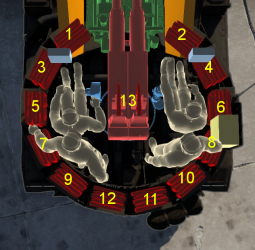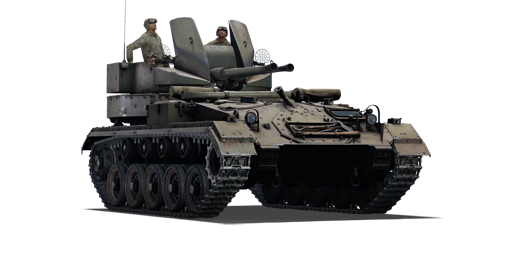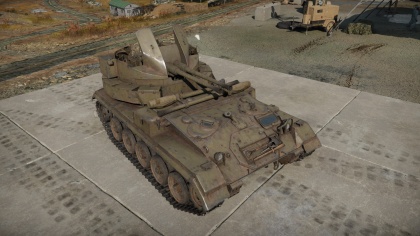M19A1
Contents
Description
The Twin Gun Motor Carriage M19A1 is a rank American Self-Propelled Anti-Aircraft (SPAA) gun
with a battle rating of (AB), (RB), and (SB). It is one of the first American vehicles to be released with the American ground tree in Update 1.45 "Steel Generals". Armed with a dual-mounted Bofors 40 mm gun system, the M19 provides a substantial firepower upgrade over the standard .50 calibre machine guns and 37 mm autocannon used in its predecessors M16 MGMC and M15 CGMC.
The M19 TGMC is a Self Propelled Anti-Air vehicle. Not much more to say. Stay behind and close to allies, but outside the enemies view-range and with a clear line of sight to the horizon for low aircraft.
General info
Survivability and armour
Armour type:
- Rolled homogeneous armour (hull, turret)
| Armour | Front (Slope angle) | Sides | Rear | Roof |
|---|---|---|---|---|
| Hull | 12.7 mm (59°) Upper glacis 12.7 mm (45°) Lower glacis |
12.7 mm (11°) | 12.7 mm | 12.7 mm |
| Turret | 12.7 mm (cylindrical) Gun shield - lower part 12.7 mm (spherical) Gun shield - upper part |
8 mm (cylindrical) 8 + 12.7 mm (cylindrical) Turret base |
8 mm (cylindrical) 8 + 12.7 mm (cylindrical) Turret base |
Notes:
- Suspension wheels are 10 mm thick while tracks are 15 mm thick.
The M19A1 is so lightly armoured that it is very vulnerable to nearby ammorack detonations, bomb blasts and even heavy MG fire can reliably penetrate the vehicle from beyond 1,000 m. As the M19A1 has an open-topped turret, gun servants are also very exposed to MG fire, artillery strikes and plane strafings.
Mobility
| Game Mode | Max Speed (km/h) | Weight (tons) | Engine power (horsepower) | Power-to-weight ratio (hp/ton) | |||
|---|---|---|---|---|---|---|---|
| Forward | Reverse | Stock | Upgraded | Stock | Upgraded | ||
| Arcade | Expression error: Unexpected * operator. | 420 | Expression error: Unexpected round operator. | __.__ | |||
| Realistic | 262 | Expression error: Unexpected round operator. | __.__ | ||||
Armaments
Main armament
Give the reader information about the characteristics of the main gun. Assess its effectiveness in a battle based on the reloading speed, ballistics and the power of shells. Do not forget about the flexibility of the fire, that is how quickly the cannon can be aimed at the target, open fire on it and aim at another enemy. Add a link to the main article on the gun: {{main|Name of the weapon}}. Describe in general terms the ammunition available for the main gun. Give advice on how to use them and how to fill the ammunition storage.
| 40 mm Bofors (x2) | Turret rotation speed (°/s) | Reloading rate (seconds) | ||||||||||||
|---|---|---|---|---|---|---|---|---|---|---|---|---|---|---|
| Mode | Capacity (Belt) | Fire rate | Vertical | Horizontal | Stabilizer | Stock | Upgraded | Full | Expert | Aced | Stock | Full | Expert | Aced |
| Arcade | 352 (8) | 120 | -5°/+85° | ±180° | N/A | 23.8 | 32.9 | 40.0 | 44.2 | 47.0 | 0.65 | 0.58 | 0.53 | 0.50 |
| Realistic | 23.8 | 28.0 | 34.0 | 37.6 | 40.0 | |||||||||
Ammunition
- Default: AP-T · HEFI-T* - The belt composition means that 50% of the shells (HEFI-T*) are useless against tanks. However, this belt is reliable against open-topped or lightly armoured targets like SPAA vehicles as well as against planes.
- Mk.II: HEFI-T* - This belt does little damage against armoured targets and should be used especially against aircraft or open-topped vehicles. The high-explosive filler is deadly to crew members.
- M81A1: AP-T - This belt offers decent damage against lightly armoured tanks, especially at close range. While the damage effects post-penetration can be quite poor, the rapid fire from the autocannon can remedy this problem by following up quickly with another penetrating shot. In close combat, these shells should be used against modules and crew member to make the most of each shell.
| Penetration statistics | |||||||
|---|---|---|---|---|---|---|---|
| Ammunition | Type of warhead |
Penetration @ 0° Angle of Attack (mm) | |||||
| 10 m | 100 m | 500 m | 1,000 m | 1,500 m | 2,000 m | ||
| Default | AP-T/HEFI-T* | 72 | 69 | 58 | 47 | 38 | 30 |
| Mk.II | HEFI-T* | 3 | 3 | 3 | 3 | 3 | 3 |
| M81A1 | AP-T | 72 | 69 | 58 | 47 | 38 | 30 |
| Shell details | |||||||||
|---|---|---|---|---|---|---|---|---|---|
| Ammunition | Type of warhead |
Velocity (m/s) |
Projectile Mass (kg) |
Fuse delay (m) |
Fuse sensitivity (mm) |
Explosive Mass (TNT equivalent) (g) |
Ricochet | ||
| 0% | 50% | 100% | |||||||
| Mk.II | HEFI-T* | 874 | 0.86 | 0.0 | 0.1 | 63 | 79° | 80° | 81° |
| M81A1 | AP-T | 874 | 0.88 | N/A | N/A | N/A | 47° | 60° | 65° |
Ammo racks
| Full ammo |
1st rack empty |
2nd rack empty |
3rd rack empty |
4th rack empty |
5th rack empty |
6th rack empty |
7th rack empty |
8th rack empty |
9th rack empty |
10th rack empty |
11th rack empty |
Visual discrepancy |
|---|---|---|---|---|---|---|---|---|---|---|---|---|
| 44 | 22 (+22) | 20 (+24) | 18 (+26) | 16 (+28) | 14 (+30) | 12 (+32) | 10 (+34) | 8 (+36) | 6 (+38) | 4 (+40) | 2 (+42) | Yes |

Notes:
- There are 8 rounds loaded into each magazine.
Usage in the battles
With the Dual 40 mm Bofors the M19 has an excellent weapon against bombers and armoured attackers. The ammo is limited though, so reserve the fire for certain hits. Against fighters, the same tactic should be applied.
Compared to certain other SPAAs (ZSU-37, Wirbelwind, Multiple Gun Motor Carriage M13, etc.), the M19 cannot be used as effectively in an anti-vehicle role, so stay behind your allies and watch the skies for enemy aircraft. If contact with ground targets is inevitable however, aiming for a targets' cannon barrel or tracks is a valid option. If flanking is available, take the opportunity and load some shells into their sides or rear. However be very careful, your crew members are exposed to machine gun fire and can easily be knocked out. This is a problem especially if it's coming from enemy aircraft, as they can also easily kill your crew. So take caution if using the M19 in an anti-vehicle role.
Modules
| Tier | Mobility | Protection | Firepower | ||
|---|---|---|---|---|---|
| I | Tracks | Parts | Mk.II | Horizontal Drive | |
| II | Suspension | Brake System | FPE | M81A1 | Adjustment of Fire |
| III | Filters | Crew Replenishment | Elevation Mechanism | ||
| IV | Transmission | Engine | Artillery Support | ||
Pros and cons
Pros:
- Heavy anti-air firepower
- Powerful 40 mm HE shells, can decimate/critically damage aircraft
- Good mobility
Cons:
- Open top, exposing loaders and gunners
- Compared to other SPAA at the same rank, poor anti-vehicle performance
- Little armour
- Decreased mobility off-road
History
Development
The development of this vehicle began from the T65 project. The T65 was classified as the 40 mm Gun Motor Carriage T65 and was based off the chassis of the M5 Stuart as requested by US Army Armored Force for a light anti-aircraft vehicle. The T65 was a successful vehicle and went on for about 1,000 units produced, however, it stopped because the production line for the Stuart chassis was phased out as well. As a replacement, the Armored Force peered into the new light tank entering production, the M24 Chaffee, as the basis of their new light anti-aircraft vehicle. This project was called the T65E1 and was being developed at the same time with the M24 (still in development as the T24). The layout for the T65E1 on the new chassis was similar to the one used with Stuart's chassis, with the gun turret at the rear and engine at the middle, and only a few changes were made like changing the original vertical gun shield into an angular one.
The T65E1 was accepted in May 1944 and designated as the Twin Gun Motor Carriage M19. An order of 904 of these vehicles was sent to Cadillac, but production didn't start until August and the factory was only able to make 285 units before the war ended due to diversion in parts to creating full M24 Chaffees. An upgrade made during its production life was designated the M19A1 and had an auxiliary engine and generator to operate the 40 mm cannons in case the main engine is disabled, plus an extra compartment to hold two spare barrels for the gun should they be damaged or overheated.
Combat usage
The M19 TGMCs that were produced were sent to Europe and used by the US Army. However, by the time the M19 was available for use, the German Luftwaffe had been decimated by the Allied air superiority, thus the M19 use as an anti-aircraft gun has been diminished greatly. The M19, like its many anti-aircraft vehicle designs made before it, found great service as an assault gun, where its 40 mm twin cannons can deliver much more firepower than its predecessors with either only .50 calibre machine guns (M16 MGMC), or a 37 mm autocannon (M15 CGMC). The M19 was never exported to America's allies in the Lend-Lease Act, and not even after the war with the Military Aid Program. Despite that, the M19 still saw use in America up to the Korean War for nearly the same purposes it was given for in World War II as a ground support weapon. It was used as a defensive turret against charging North Korean and Chinese forces when they try to overrun infantry positions, to which it served with devastating effect. Its effect against enemy aircraft is dubious during the war.
When the M24 Chaffee and its chassis derivatives were finally phased out of service in 1956 for newer tanks in production, the M19 was no exception. However, the M19 40 mm turrets were removed from the chassis and was simply put onto the next light tank chassis that was to take over the role the M24 Chaffee was built for. This light tank was the M41 Walker Bulldog and the M19 turret-mounted chassis was named the M42 Duster.
In-game description
"Combat experience in 1941-1942 showed that the troops needed a mobile anti-aircraft system capable of escorting mechanized columns and protecting against enemy aircraft. Development of the new vehicle began in 1942. The first prototype of the T65 self-propelled artillery piece was created using the M5A1 light tank chassis, though it was replaced during trials with the M24 light tank's more modern version.
The hull's nose section was home to the transmission and the driver's compartment, in which the driver (left) and commander (right) were located. The roof of the driver's compartment had hatches and periscopes, while the engine was located in the center section. The battle compartment was in the rear section, on the roof of which was an open-air turret system mounted in the front with two electrically fired 40 mm Bofors automatic cannons. The turret was rotated using a manually operated electrohydraulic actuator. Ammunition included high-explosive and incendiary rounds, while the crew was armed with two 11.43 mm Thompson submachine guns and four 7.62 mm carbines.
By September 1945 Cadillac and Masse-Harris had produced 285 (300 by other calculations) units, and by the end of 1945 they had begun to join tank divisions. They saw combat in the Korean War from 1950 to 1953. The primary goal of the M19 was to fight off land targets, something they were good at through the entire campaign, and they remained in the US army until 1956."
Media
- Skins
- Videos
See also
- Vehicles equipped with the same chassis
- Other vehicles of similar configuration and role
External links
- [Development] Steel Generals: M19
- [Development] Developers about the M19
- [Wikipedia] M19 Multiple Gun Motor Carriage
- [Military Factory] M19 Gun Motor Carriage (M19 Twin 40mm)
| USA anti-aircraft vehicles | |
|---|---|
| M3 Half-track derivatives | M13 MGMC · M15 CGMC · M16 MGMC |
| M24 derivative | M19A1 |
| M41 derivative | M42 |
| Radar SPAAG | M163 · M247 |
| Missile SPAA | ADATS · Imp.Chaparral · LAV-AD · XM975 |





